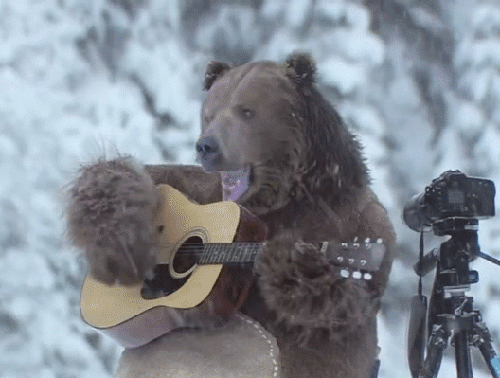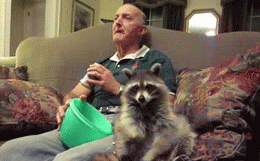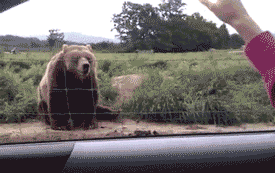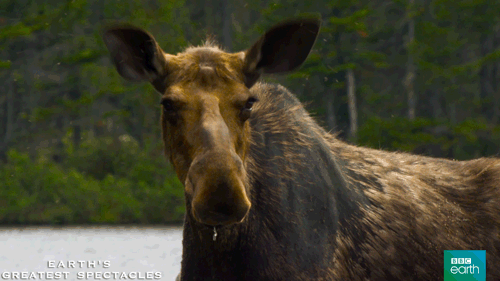How to not be a jerk to wildlife in Canada
Coming to Canada for the first time usually involves equal parts excitement and terror around our sometimes-legendary wildlife. Yes, we have bears and moose and cougars and bison and more bears here. Also the less terrifying ones like chipmunks and raccoons (actually terrifying, fyi) and beavers. The problem is, almost all of them are super cute, so if you do cross paths with one on your travels, the urge to get close to them is pretty hard to resist. But cute as it all is, Canada’s wildlife is still definitely wild, and every year a handful of tourists get themselves into trouble by, well, acting like jerks. Here’s how to experience the thrill of the wild, while also not making any enemies out there.
1. Keep your distance
No matter how cute they are or how totally on board they appear to be with your presence, keep a healthy distance from wildlife to avoid things getting uncomfortable. Everything can seem fine until the moment it isn’t, which is usually when the animal decides without warning that “I’VE HAD QUITE ENOUGH, THANKYOUVERYMUCH” and you’re within swatting/biting/charging/mauling distance. No thanks.

2. Watch out for momma
All wildlife should be respected but momma mammals deserve an extra little bit of reverence. If you get in between a momma bear and her cub or a momma cougar and her kitten, you’re asking for trouble. Their protective instincts are somethin’ fierce. Keep in mind that springtime is typically baby season so be extra vigilant for moms at this time of year. And if you see a baby and no sign of mom? Don’t worry, she’s probably got eyes on you already.

3. Visit them at rescue centres
All across the country there are wildlife rescue centres that take in wounded or otherwise unwell animals and rehabilitate them, either for release back into the wild or not (depending on the situation). Most open themselves up for visits from the public, which is a great time to see some of Canada’s most majestic beasts up close while learning a few things.

4. Don’t feed them
Just don’t. Don’t! It doesn’t matter how many people you see chucking peanuts to chipmunks or tossing bread crusts at geese or leaving a steak out in bear country, animals are not meant to eat human food. Not only does it draw their attention to you, it habituates them to humans and human food, which messes with their biology and everybody’s well-established ecosystems, which can be dangerous for everyone. Oh, and it’s illegal in national parks (to the tune of a $25,000 fine).

5. Clean up after yourself for once
If you go out in the woods today, take a garbage bag. And use it. Leave No Trace is an excellent philosophy built around taking it easy on the planet, but it also does a world of good for the local wildlife, as garbage is all too appealing to most animals and exposing a chipmunk or a bear to your half-empty Doritos bag not only desensitizes them to human foods and smells (see #4), the packaging can also become a wildlife trap.

6. Keep driving (even if everyone else is stopped)
This one is huge, and pardon me while I channel your mom for a minute. Just because everyone else is jumping off a bridge/stopping along the highway and getting out of their cars to approach a family of bears doesn’t mean you have to, too. If you’re travelling along the Icefields Parkway in the summer, you’ll see this kind of scene all the time—a line of cars pulled over and tourists with cameras and phones pointed all in one direction. This kind of thing drives park wardens crazy. They call them bear jams, which involve way fewer banjos than you might hope. Not only is it a little bit disrespectful, it can also be super dangerous for you, the animals and other cars on the road. If you must, pull over and stay in your car and then carry on your merry way.

7. Get to know them ahead of time
You know how you creep your Tinder dates before go-time just to gather a little recon on what you’re up against? Facebook usually reveals a bit of intel, LinkedIn, too, and if you’re real good at it and have a last name to work with, you can find their time on that 10k race they ran six years ago. It’s natural. Same thing applies when you’re heading out into the Canadian wilderness—the more you know about what you’re about to face, the better time you’ll have. So swing by the Wikipedia entries on elk, brown bears and chipmunks and not only will you go in with a better understanding of what rutting season really entails (see #9), you’ll also have a ton of interesting conversation fodder for your next Tinder date. Win win.

8. Hike safely (and know what that means)
Safety on the trails isn’t just a matter of wearing comfortable shoes and bringing adequate water (though both of those are pretty important). If you’re traipsing through a bear’s living room or a cougar’s dining room, you’re gonna want to take some extra precautions, which are akin to knocking before you enter. Wearing bells and/or making noise as you hike is a good way to alert any locals that you’re in the area, because nothing pisses off an animal like the element of surprise. If they hear you coming, they can clear out (and despite their reputation as extroverts, they’d really rather clear out) before you lay eyes on them, which is nicer for everyone. If you do cross paths with an animal, you should know what to do (and what that is depends on what animal it is). Parks Canada is a good source of tips and advice.

9. When the forest’s a-rockin’...
There are a few times in an animal’s life when you really don’t want to get too close—when they’re hungry, or when they’re looking for a little action. Take elk, for example. Come fall, aka rut season, they’ve got pretty much one thing on their minds and it involves looking for love. That’s a recipe for a lot of aggressive behaviours so give them an extra bit of privacy as they do their thing.
Issue 7



